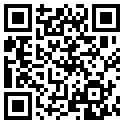
Earthquakes: Tectonic Plates
The Earth is formed of four concentric layers that have very different physical and chemical properties: inner core, outer core, mantle and crust.
- The centre or inner core is the hottest part of planet Earth. A solid mass of iron and nickel this centre has temperatures up to 5,500 degrees Celsius. With this extraordinary heat the inner core functions as engine for the planet:
- Surrounding the outer core is the outer core, a liquid layer of iron and nickel, extremely hot, this layer has similar temperatures to the inner core:
- The widest section of the Earth is the mantle with an approximate diameter of 2,900 km. The mantle is composed of semi-molten rock called magma. The upper parts of the mantle are hard rock but deeper within the rock is softer and beginning to melt:
- The outer layer of the planet is known as the crust. It is a solid rock layer which averages about 60 kilometers in thickness.
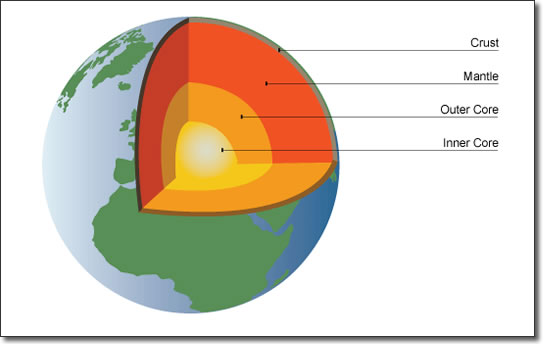
The crust and the upper mantle form a cold, strong layer known as the "lithosphere" (from the Greek for "rocky" sphere) floating on the inner mantle. The lithosphere is fragmented into a dozen of huge, irregularly shaped pieces, called tectonic plates, which are in constant motion and slide over, under and past each other on top of the partly molten inner layer. There are two kinds of plates: oceanic crust (i.e. the plates under the ocean) and continental crust.
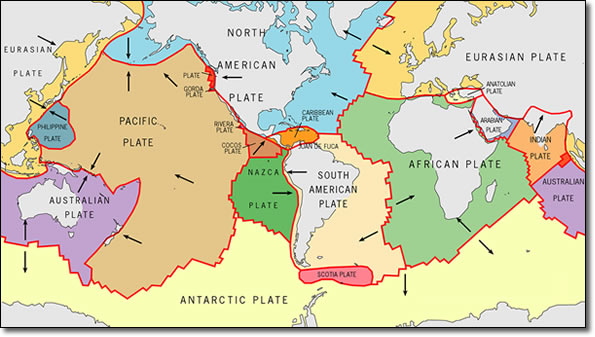
There are 7 large and many small moving plates. The plates have a depth of 50 miles and on average they move only a few inches a year relative to one another. Coastlines and plate boundaries do not always align.
Although the upper mantle is solid rock, it slowly flows in a convection current because of heat dissipating from the core. Convection currents in the mantle cause the plates to move several centimeters a year in different directions.
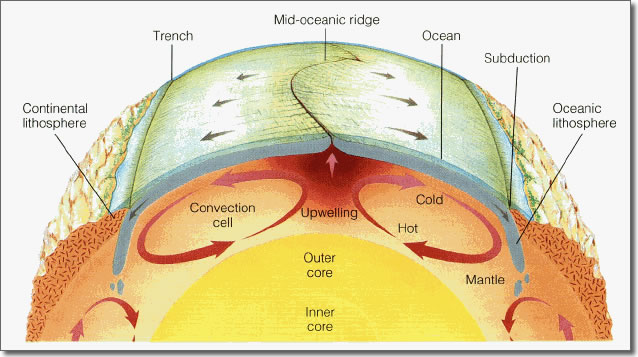
If you look at the convection currents, you'll see that:
- as the hotter Mantle rises cooler material sinks;
- the material rises and spreads out while the crust splits and diverges;
- the plates converge and subduct as the material sinks.
Stress is exerted the plates as they move and those around them. They may collide, sink, or pull apart as the plates scrape boundaries creating stress which results in strain setting energy free. Subduction occurs when plates collide and one is drawn beneath another. This process can take thousands of years. The collision of plates creates mountains as rock layers are forced upward. As the plates diverge lava pushes through the mantle, cools and forms a new section of crust. Plates moving slowly along side each other create friction and intense heat as they slide resulting in volcanic activity if the rock melts. Earthquakes can occur if the plate slips sliding away or towards each other.
In some cases this is a gradual movement. Sometimes the plates lock together unable to release the energy accumulated which builds up in the rock.
When this energy elevates to the elastic limit of the rocks, they will break free causing the ground to shake. This usually occurs when two plates either ride over, or slide against each other, and the material at the edge of the tectonic plates deforms and ruptures at its weakest point. Thus the strain energy stored within the plate is released in the form of vibrations.
Plate Boundaries
Plate Boundaries are categorized into three types:
1. Divergent boundaries (also called spreading zones)
There are places on earth where two plates are separating or spreading apart, such as at oceanic ridges. Rift valleys and faults occur when the lithosphere is under tensional stress. At spreading zones, new magma comes up from the mantle, pushing two plates apart and adding new material at their edges. Spreading zones are usually found in oceans along with mid-ocean ridges. For example, the North American and Eurasian plates are spreading apart along the mid-Atlantic ridge.
As the new material flows out of the ridge, it pushes the existing ground floor out, until it eventually sinks under another plate, which leads us into a different type of boundary. Earthquakes with low Richter magnitudes along boundaries with normal fault motion tend to be shallow focus. These quakes can have focal depths of less than 20km.This indicates the brittle lithosphere must be thin along the diverging plate boundaries.
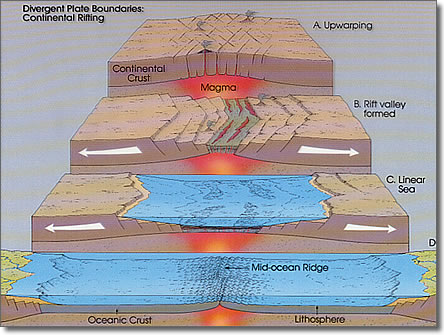
2. Transform boundaries (also called transform faults)
These are found where plates slide past one another. The San Andreas Fault is an example of a transform -fault plate boundary along the north western Mexican and California coast. Earthquakes along transform boundaries show strike-slip motion on the faults, they form fairly straight linear patterns and tend to be shallow focus earthquakes with depths usually less than about 100 km. Richter magnitudes could be large.
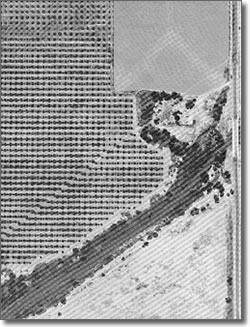
As seen in the image above, the trees (they look like small dots) in the aerial view of San Andreas fault have been offset by the slipping of the plates. The North American Plate to the right and the Pacific Plate to the left.
3. Convergent boundaries (also called transform faults)
Convergent boundaries are the place where two tectonic plates converge (i.e. two plates move toward each other). These zones tend to be where compressional stresses are active and this results in thrust or reverse faults being common. Converging plate boundaries are of two types:
- Subduction boundaries occur where oceanic lithosphere is pushed beneath continental or oceanic lithospheres. Where two plates converge at an oceanic trench a subduction boundary is formed as cold oceanic lithospheres are pushed back down into the mantle. This happens because the oceanic plate is denser than the continental plate so, as they move together, the oceanic plate is forced underneath the continental plate. In this case, one plate overrides, or "subducts" the other, pushing it slowly downward into the mantle where it melts to form magma. A subducted lithosphere remains cold and brittle as it descends and can fracture under compressional stress. These fractures generate earthquakes that define a zone of quakes at increasing focal depth under the overriding plate. This zone is called the Benioff Zone. Depths of up to 700km are reached in the Benioff Zone. Examples of subduction zones are found along the northwest coast of the United States, Mexico, western Canada, southern Alaska, South America, Central America, Japan, Philippines, Caribbean Islands and the Aleutian Islands.
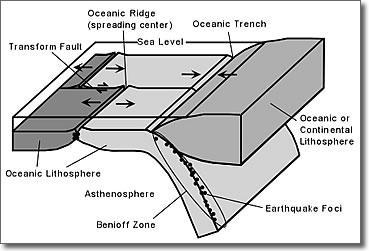
-
Collisional boundaries where two plates of continental lithosphere collide result in fold-thrust mountain belts. The continental crust is squashed together as the plates push together and is forced upwards. This is called folding. Fold mountains are created by this process of folding. Where two continental plates converge and push towards each other fold mountains can also be formed. This is how mountain ranges such as the Himalayas and the Alps were formed. Earthquakes occur due to the thrust faulting and range in depth from shallow to about 200 km. Examples are found along the Himalayan Belt into China, along the Northern edge of the Mediterranean Sea through Black Sea and Caspian Sea into Iraq and Iran.
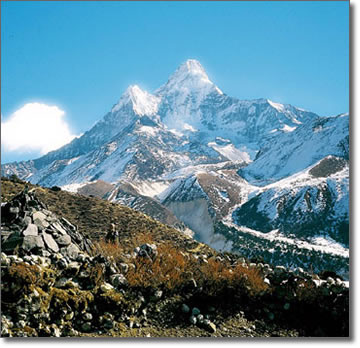 Image: A view of the Himalayas from Gorak Shep
Image: A view of the Himalayas from Gorak Shep
Convergent boundary zones are characterized by deep-ocean trenches, shallow to deep earthquakes, and mountain ranges containing active volcanoes.
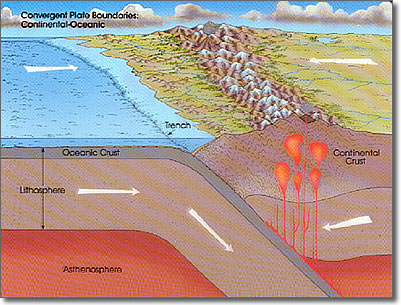
In general, where an oceanic and a continental plate collide, the denser oceanic plate will be forced under (subduction) the other.
For You and Your Loved Ones
With preparedness and safety measures, protect yourself and your family from earthquake risks.
Always good to prepare for an earthquake
Earthquake Warnings are a Game Changer
Stay protected, anytime, anywhere

HAPPY CLIENTS
ALERTS DELIVERED SINCE 2011



